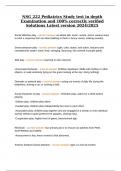NSG 222 Pediatrics Study test in depth
Examination and 100% correctly verified
Solutions Latest version 2024/2025
Social affective play - correct answer as adults talk, touch, nuzzle, and in various ways
to elicit a response from an infant (talking to them in funny voices; making sounds).
Sense-pleasure play - correct answer Light, color, tastes, and odors, textures and
consistencies (water, sand, food, swinging, bouncing, kid covered in purple paint).
Skill play - correct answer learning to ride a bicycle
Unoccupied behavior - correct answer Children daydream, fiddle with clothes or other
objects, or walk aimlessly (lying on the grass looking at the sky; doing nothing).
Dramatic or pretend play - correct answer acting out events of daily life (using the
telephone, driving a car, or rocking a doll).
Social character of play - correct answer -Onlooker play; watch for a while before
playing.
-Solitary play; children play alone.
-Parallel play; children play independently but next to each other.
-Associative play; children play together and are engaged in a similar or even identical
activity without a goal (pretend t be puppies, sharing clay).
-Cooperative play; higher level of game; teens/school age.
RESCUE - correct answer Our primary job is to rescue our patients from PAIN,
SUFFERING and HARM.
-Assessment is key; know normal to find abnormal.
Anterior fontanel closes between - correct answer ages 12 and 18 months
,Posterior fontanel usually closes at - correct answer 6 - 8 weeks
Most infants begin to fear strangers at - correct answer 6 - 8 months
By what are children able to associate meaning with words? - correct answer 10
months
rattle toy - correct answer 4 months; brightly colored toy.
Teething usually begins at what age - correct answer 6 months.
Cow milk recommended for children start at - correct answer 12 months (only whole
milk)
When should solid foods be introduced? - correct answer 4-6 months one at a time (to
lookout for allergies), at intervals of 4 to 7 days.
Safest place to put car seat is - correct answer Rear facing in back seat.
Communicating with Children - correct answer -Make communication developmentally
appropriate.
-Get on child's eye level.
-Approach child gently and quietly
-Always be truthful.
-Give child choices as appropriate.
Nursing interventions for baby - correct answer Use gentle touch when handling the
infant, allow the infant to suck on a pacifier, talk to the infant when providing care in nice
musical voice and not loud noises, quickly respond to crying, Incorporate visual,
auditory, tactile and kinesthetic stimulation into nursing care (figures hanging on cirbs),
,for VS do not start with head and warm stethoscope, do assessment 1-2 hours before
feeding.
Nursing interventions for Toddlers/Preschoolers - correct answer Focus on the child in
your communication, explain what, how , and why. Use words he or she will recognize,
be consistent; don't smile when doing painful procedures, label the child's emotions,
have toys available during procedures, utilize parents and caregivers to interact and
assist, expose one clothing at a time, introduce one instrument at a time; might have to
pretend to listen to parent first, fear of mutilation when drawing blood; put bandage on.
Avoid using a phrase that might be misinterpreted by a small child.
School age nursing interventions - correct answer Unable to think abstractly, when
appropriate, offer the child choices, explain how and why in simple, nondescript, and
non fearful terms, allow the child to participate in procedures, allow child to voice his or
her concerns, answer q's honestly and simply, concretely. Allow the child to have time to
play, explore and ask questions (tell them results of the exam and open ended
questions or that you cannot keep things confidential). Assure them that there are no
dumb questions. Let the child operate the bulb of the bp cuff.
Adolescents age nursing interventions - correct answer Open-ended questions,
encourage pt to express feelings , be honest with them, be aware of privacy needs,
explain limits of confidentiality, think about developmental regression, clarify differing
opinions and reports, incorporate genuineness, trust, active listening, respect and
rapport skills into nursing care, do not judge. Like spending time with friends, make time
for ti.
Goals of Pediatric Assessment - correct answer Minimize stress and anxiety
associated with assessment of body parts (ensure privacy), foster trusting nurse-child-
parent relationship, allow for maximum preparation of child, preserve security of parent-
child relationship, maximize accuracy of assessment findings for each body system, use
developmental age as the main criteria for assessing each body system.
Interview sample method questions - correct answer Signs and symptoms, allergies,
medications, past medical events, what precipitated their admission to the hospital,
when did they have their last meal?
, Pediatric Assessment Triangle - correct answer Initial assessment, non-invasive and
non threatening.
3 variables to determine if you have a critical or not critical pt:
1-Appearance (TICLS)
2-Work of breathing (rate, position, retractions, anxiety)
3-Circulation (cyanosis, pale, ashen, mottled; good to notice signs of shock; kids crash
quickly).
Pediatric Assessment Triangle TICLS - correct answer Tone
Interactiveness
Consolability
Look/gaze
Speech/cry
Primary Assessment - correct answer Is there something happening to patient that
could kill them right now?
Airway (color, able to talk or make noises), Breathing (6 p's), Circulation, Disability,
Exposure.
6 P's of Dyspnea - correct answer -Possible foreign body
-Pulmonary embolus
-Pneumonia (water filled)
-Pump failure
-Pneumothorax
-Pulmonary bronchial constriction.
Circulation - correct answer Palpable pulses, poor perfusion/cap refill, decreased BP
(not very accurate sign), Bradycardia (HR of 40 start CPR right away, most accurate
sign).




